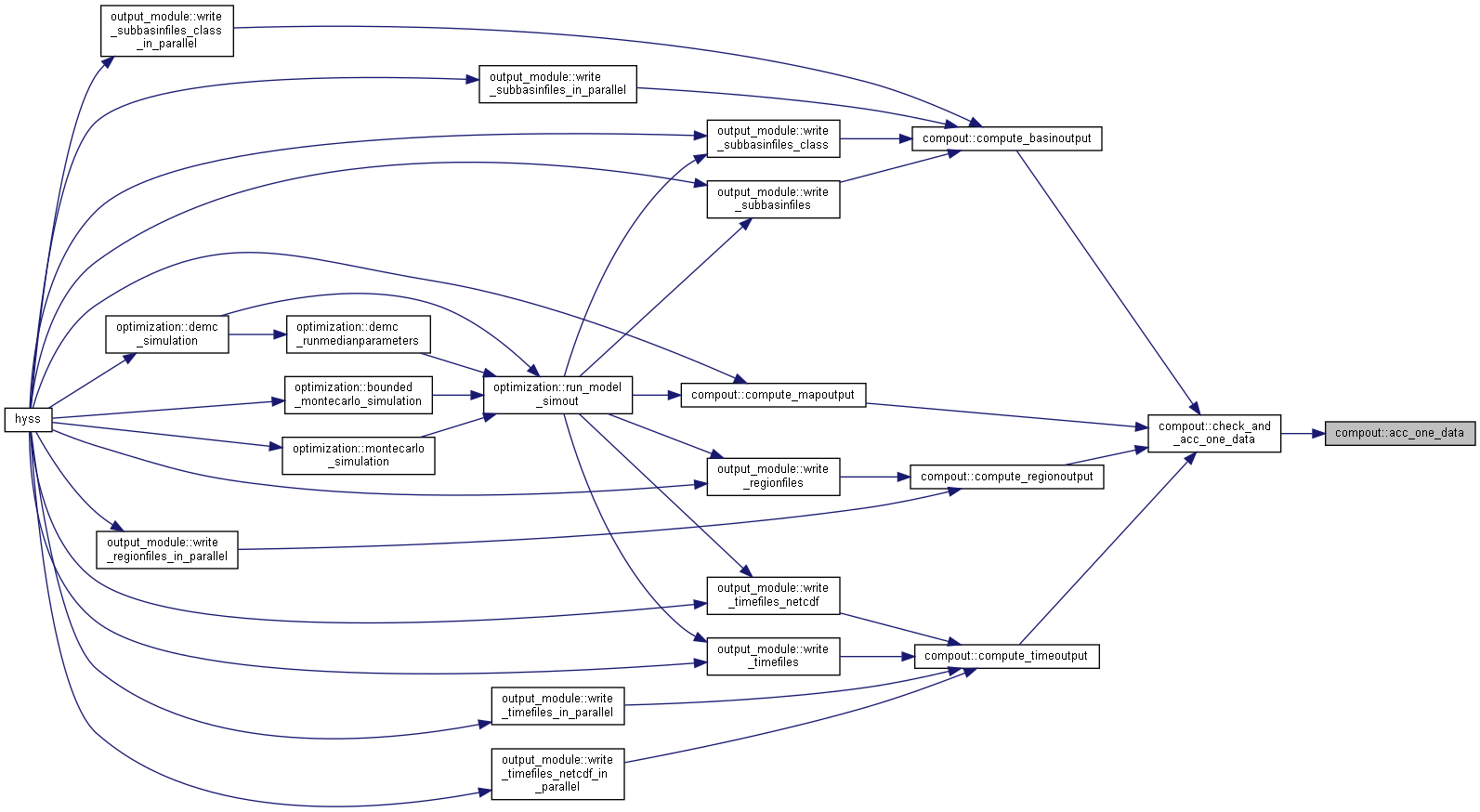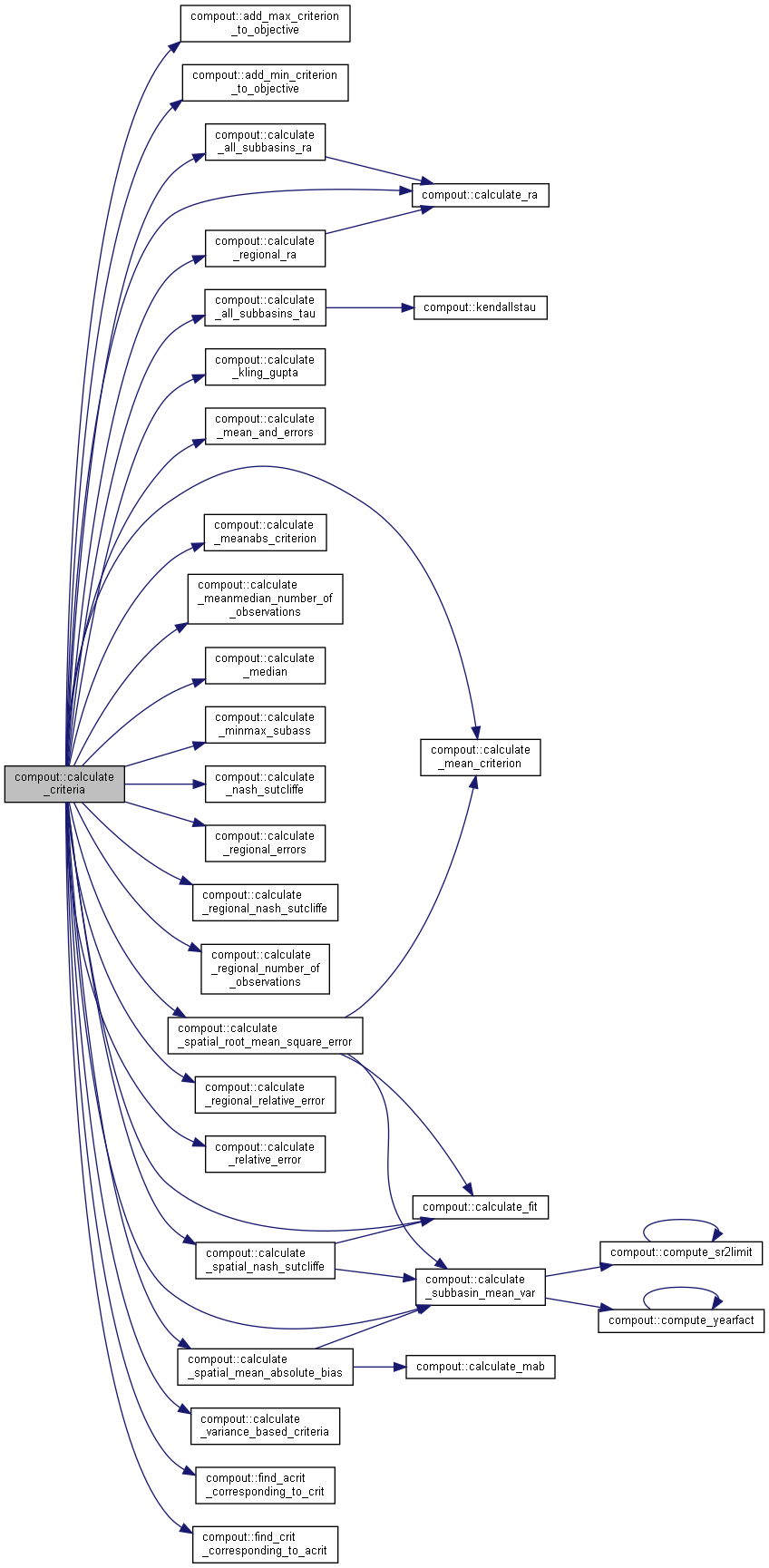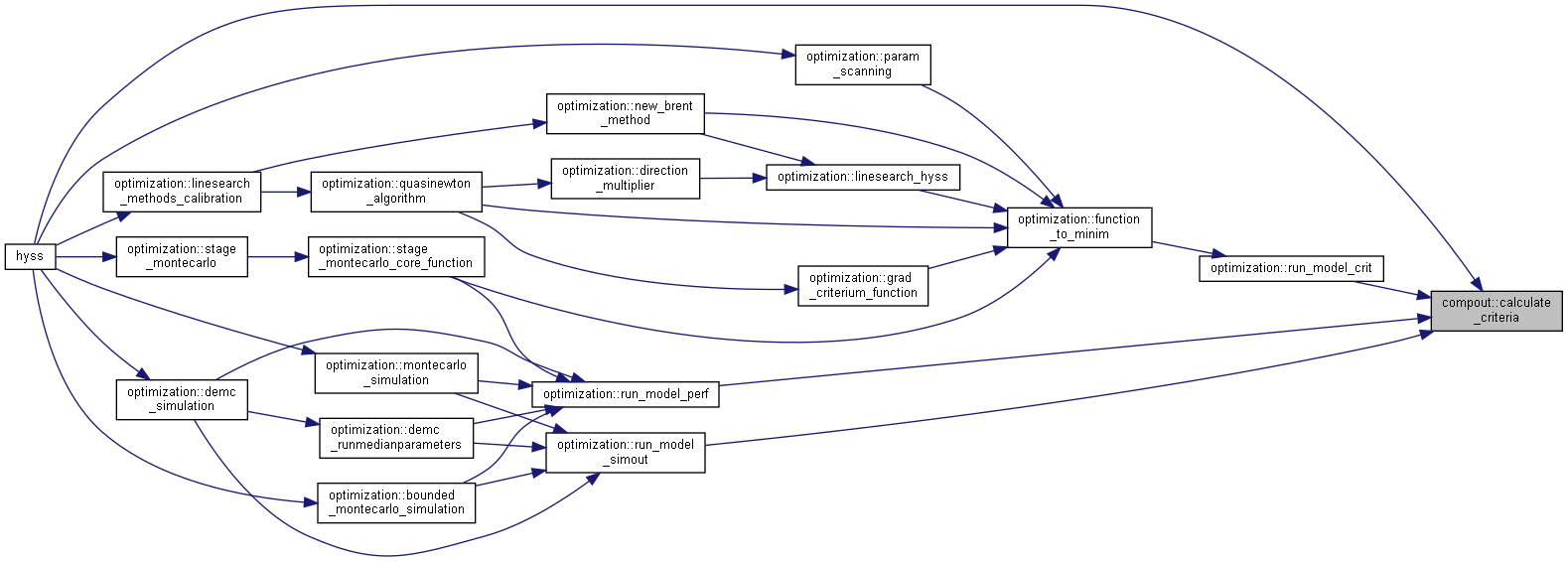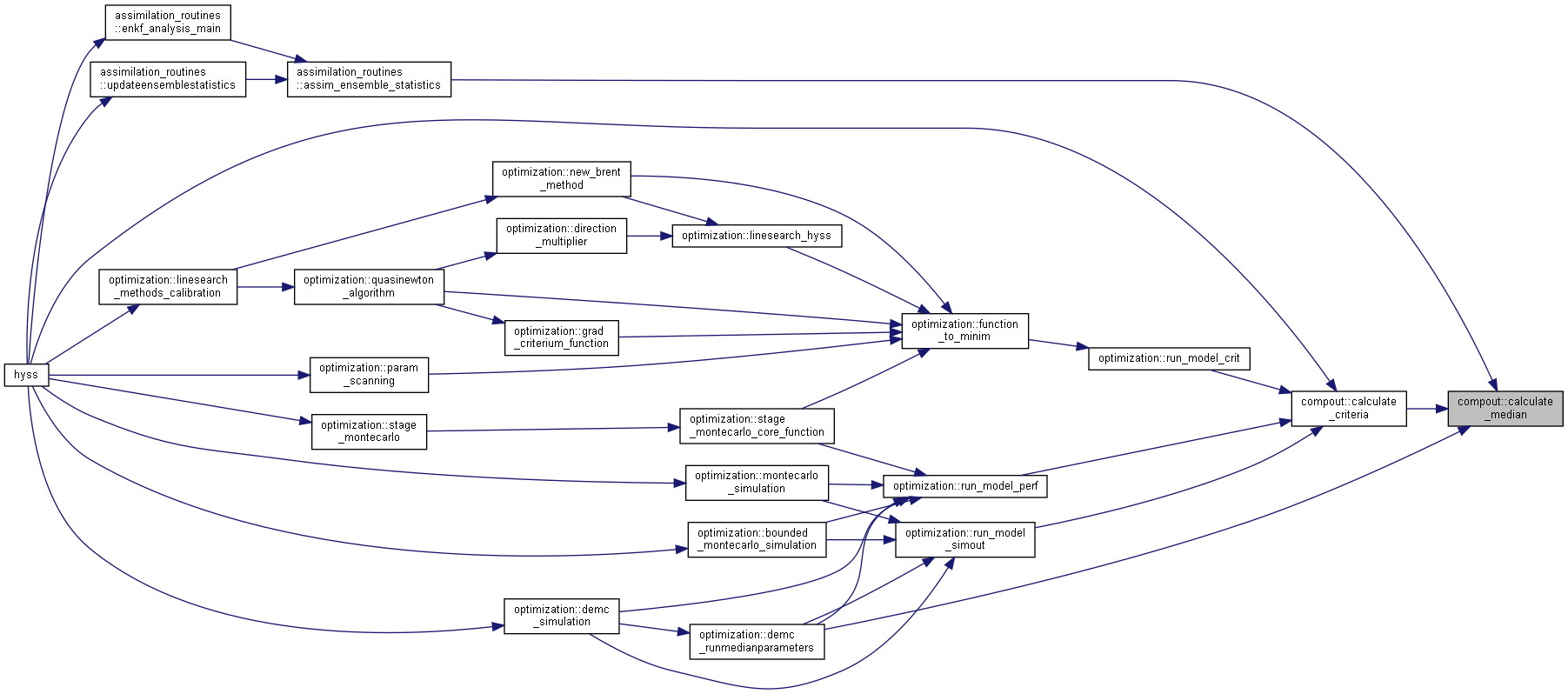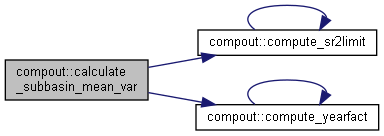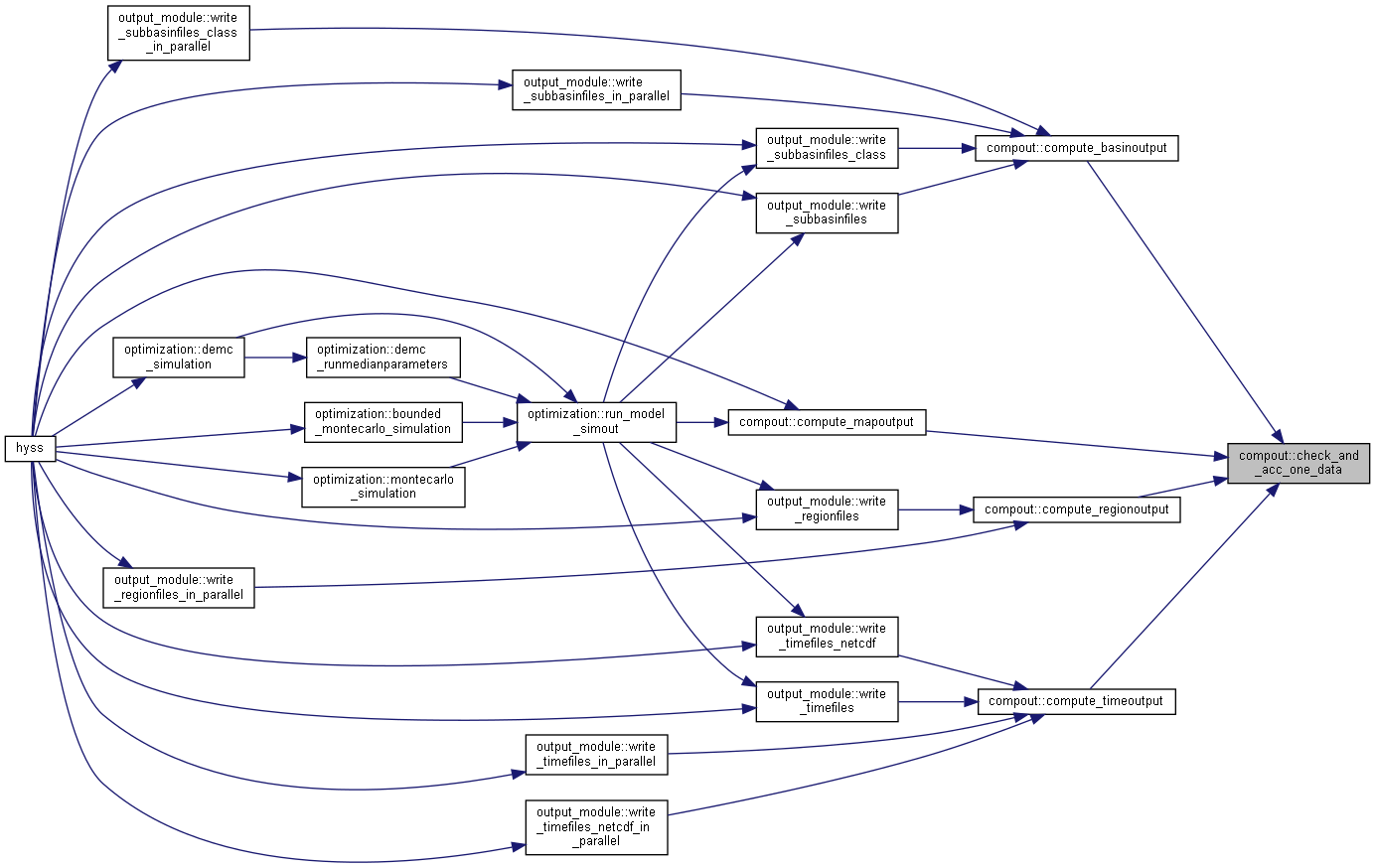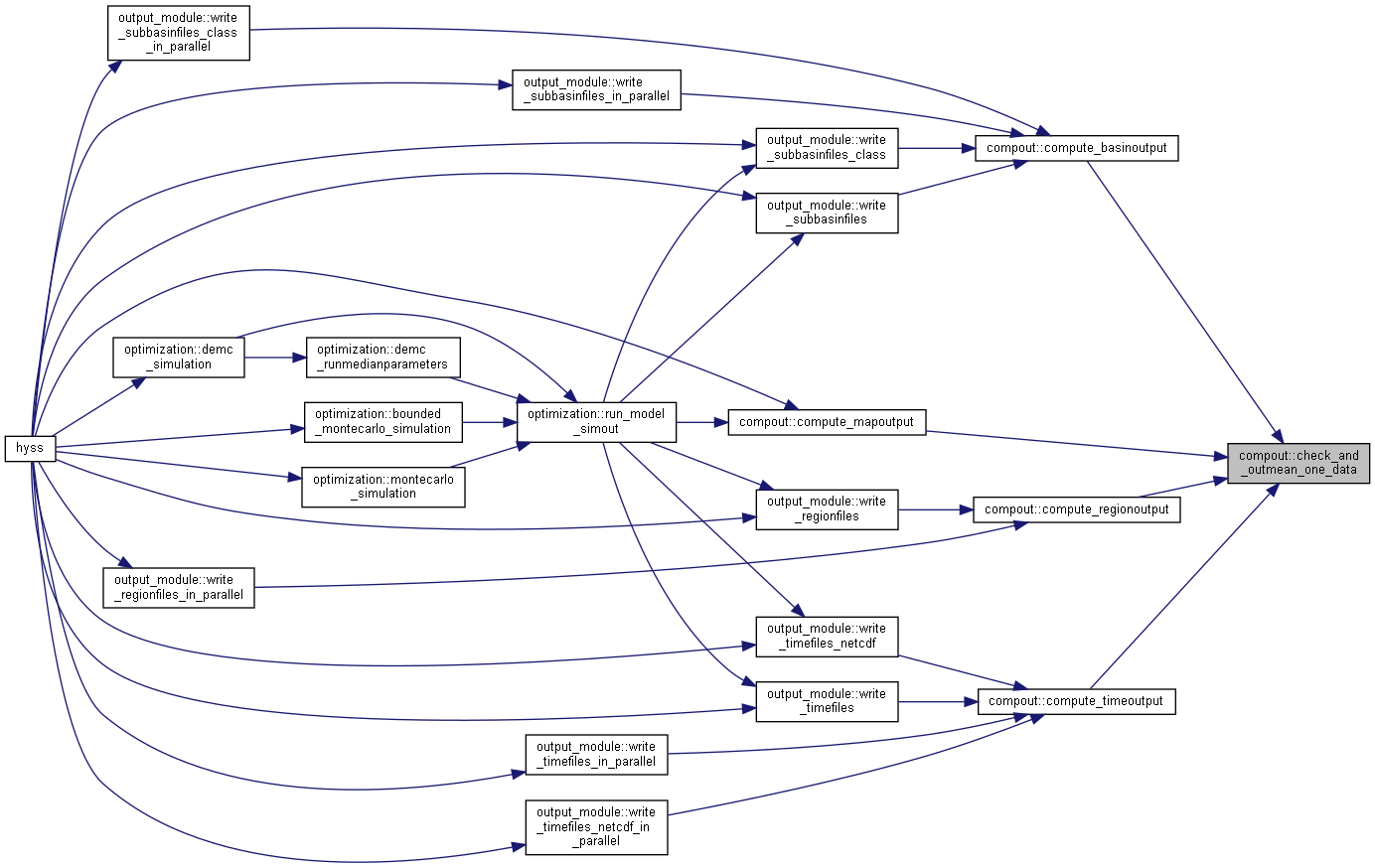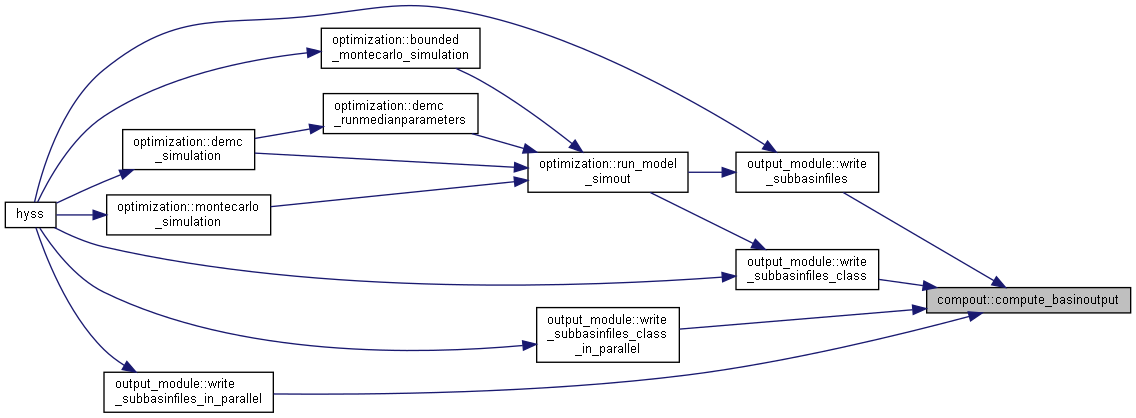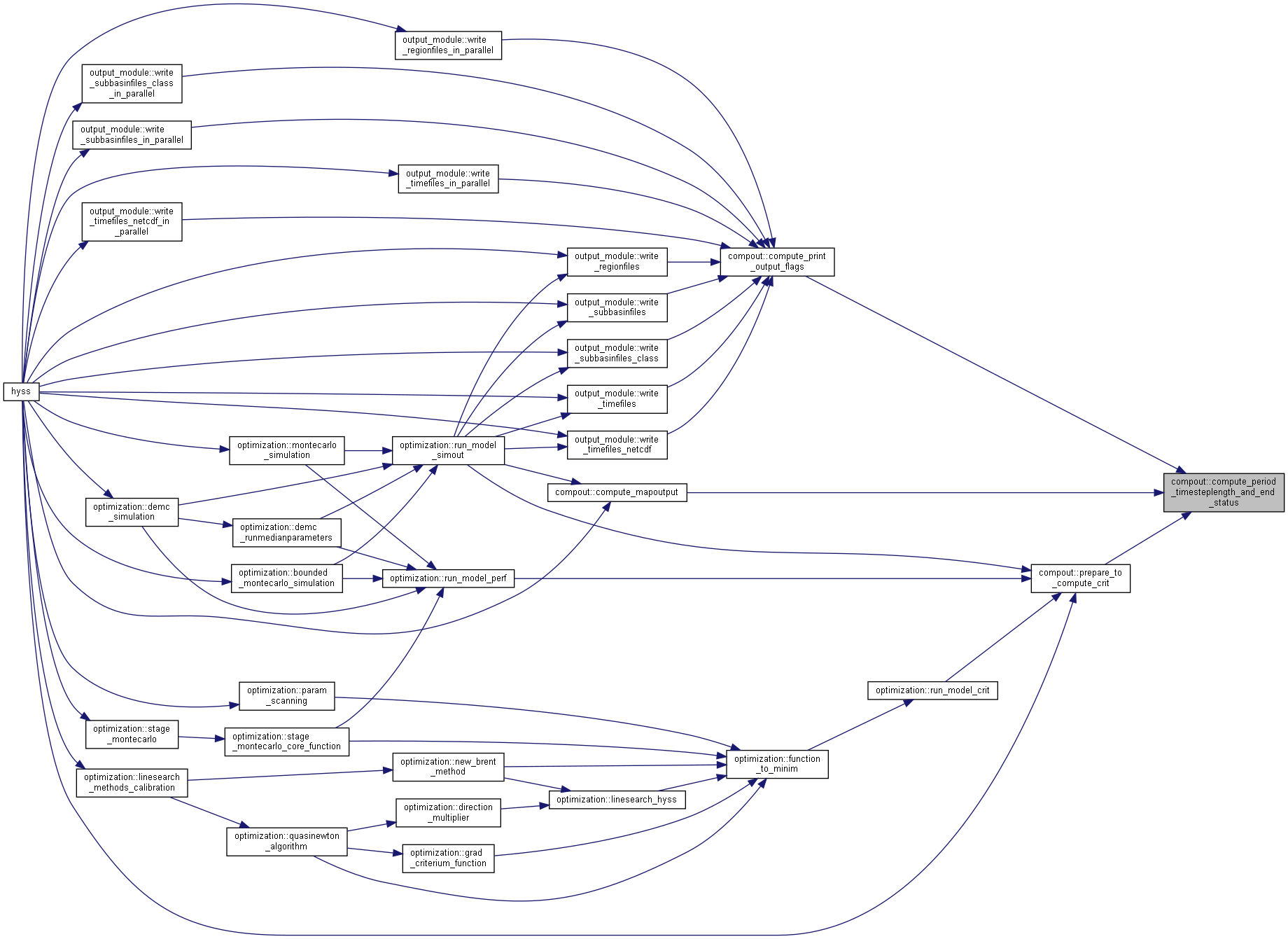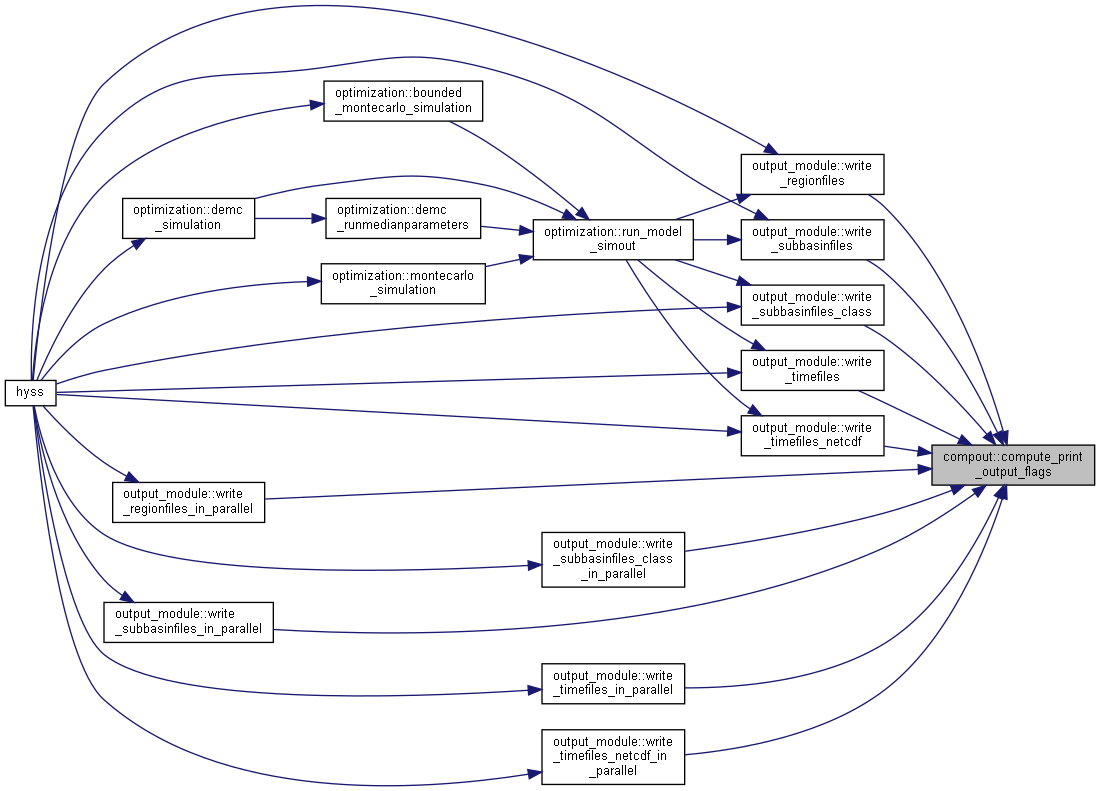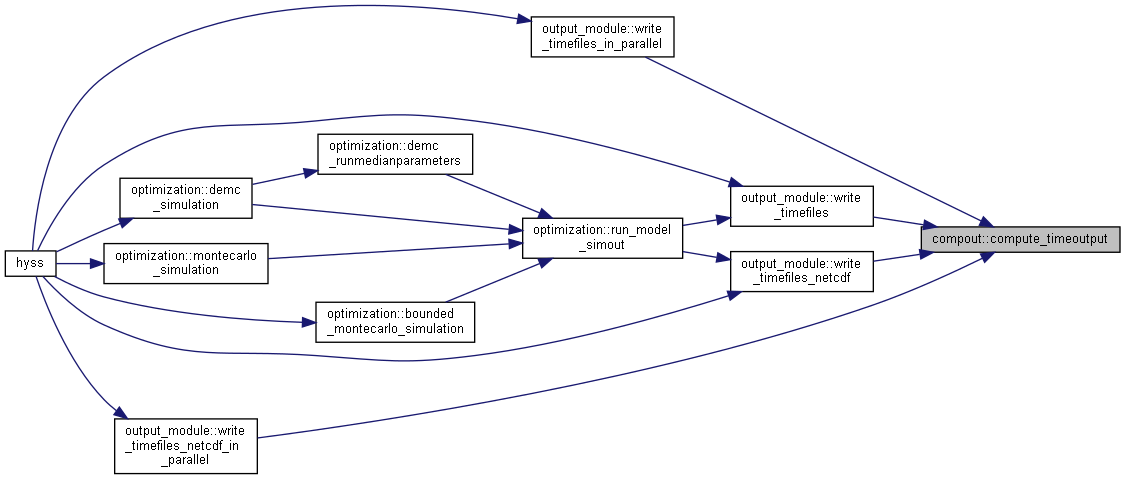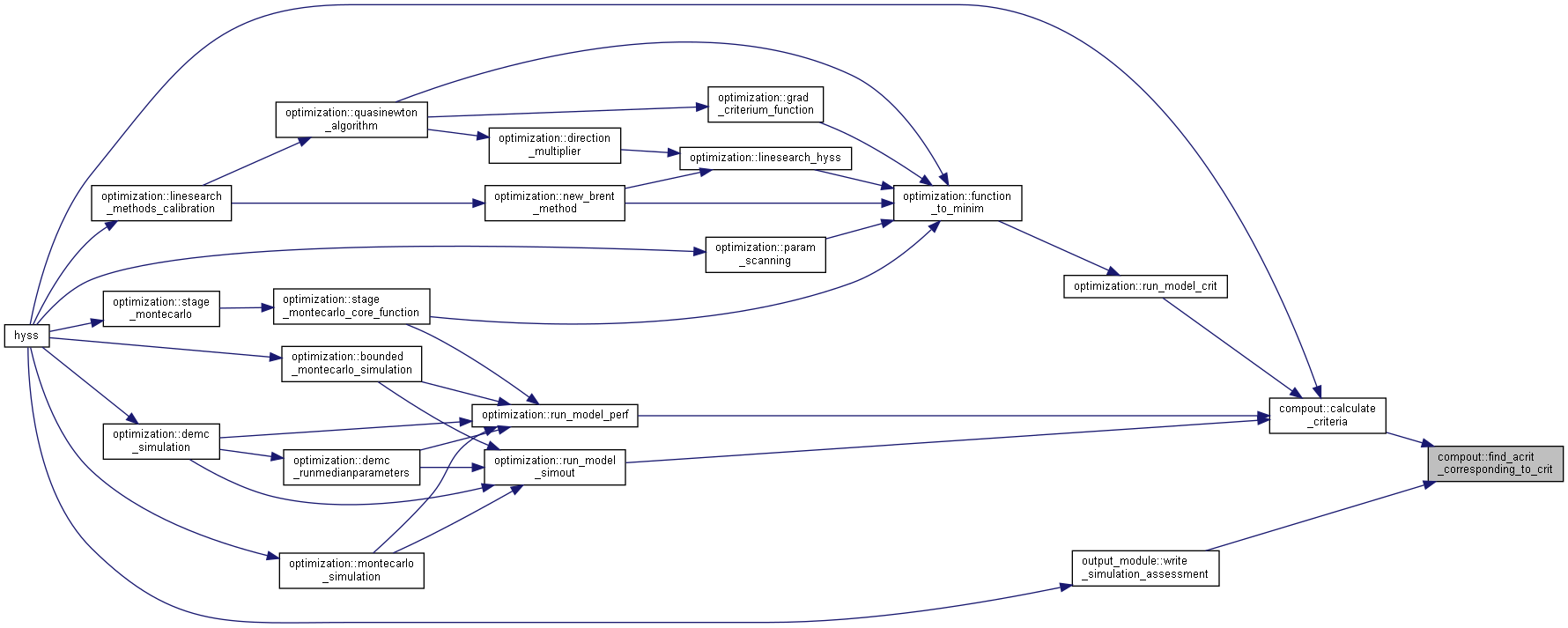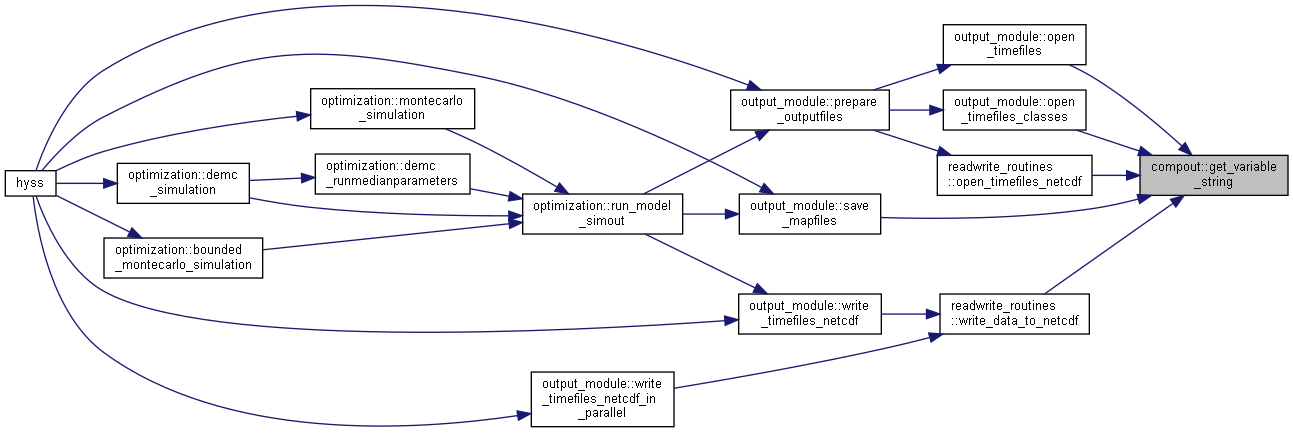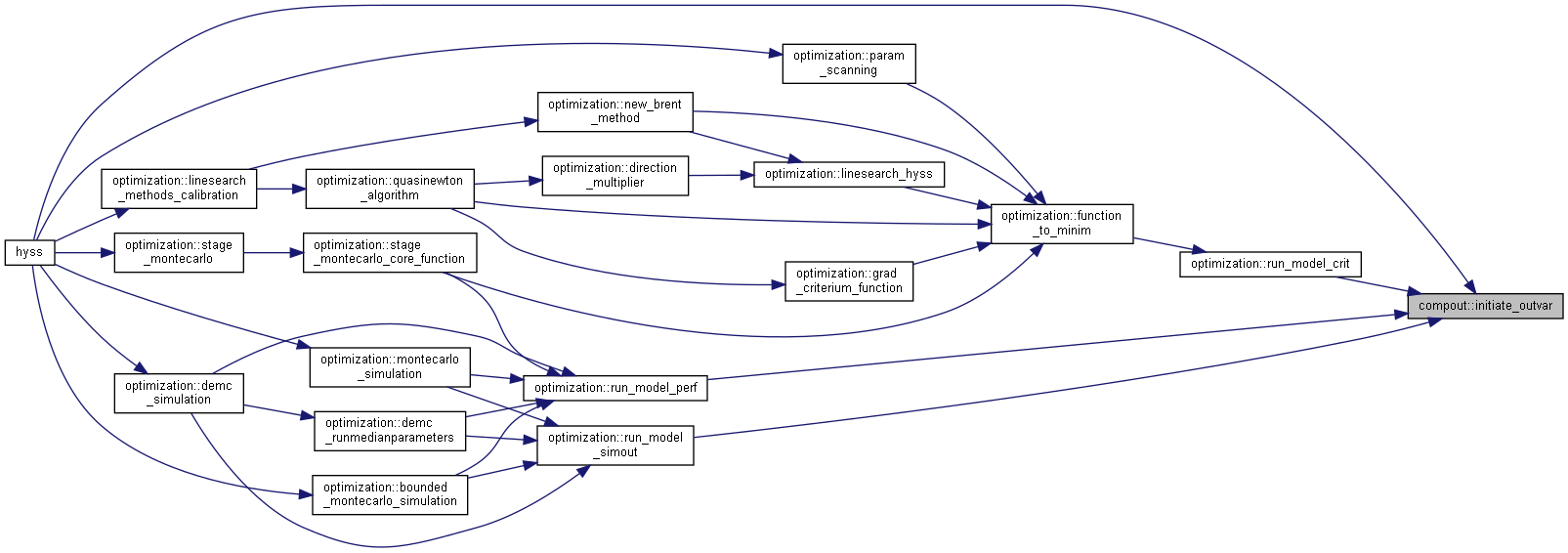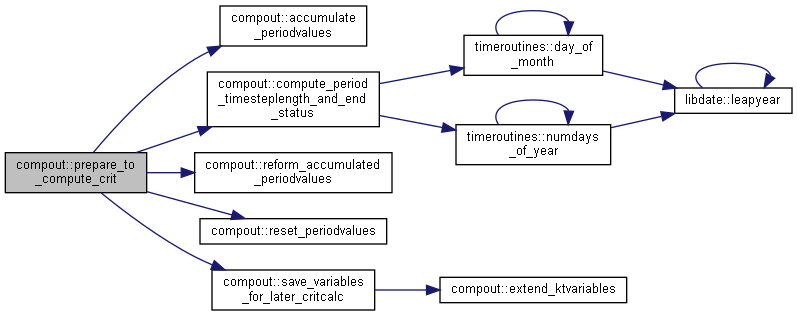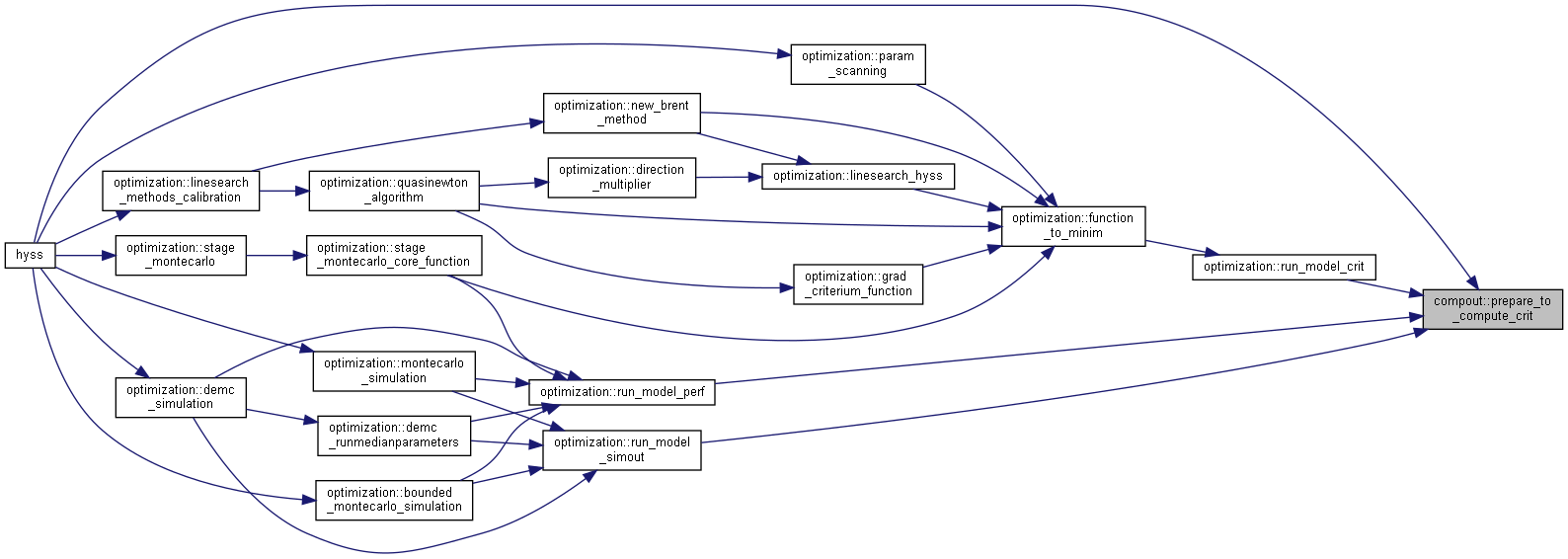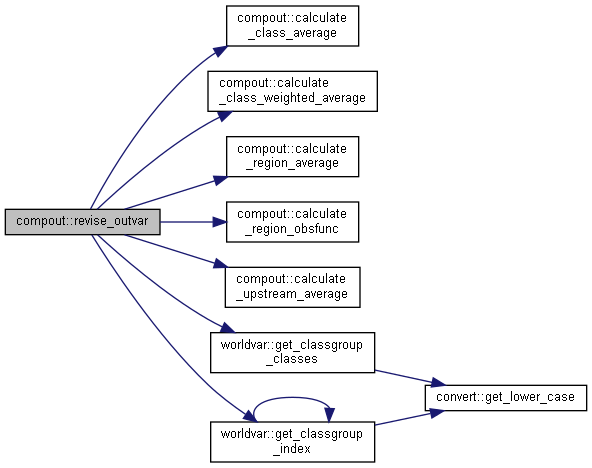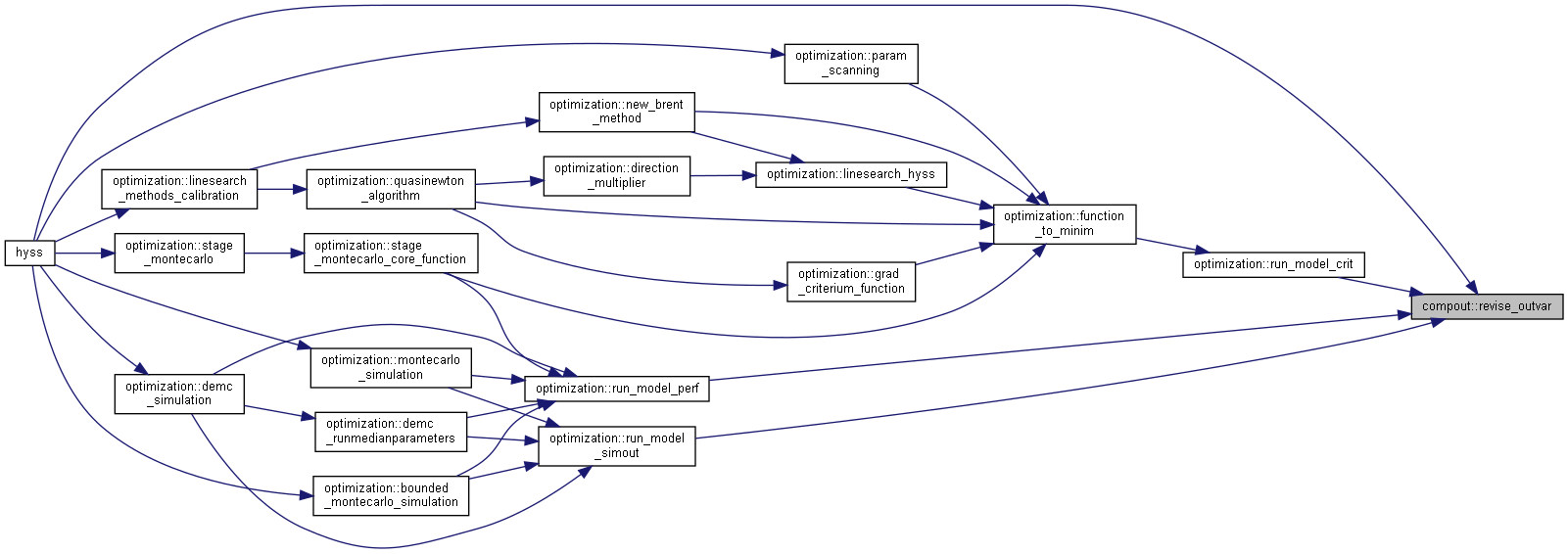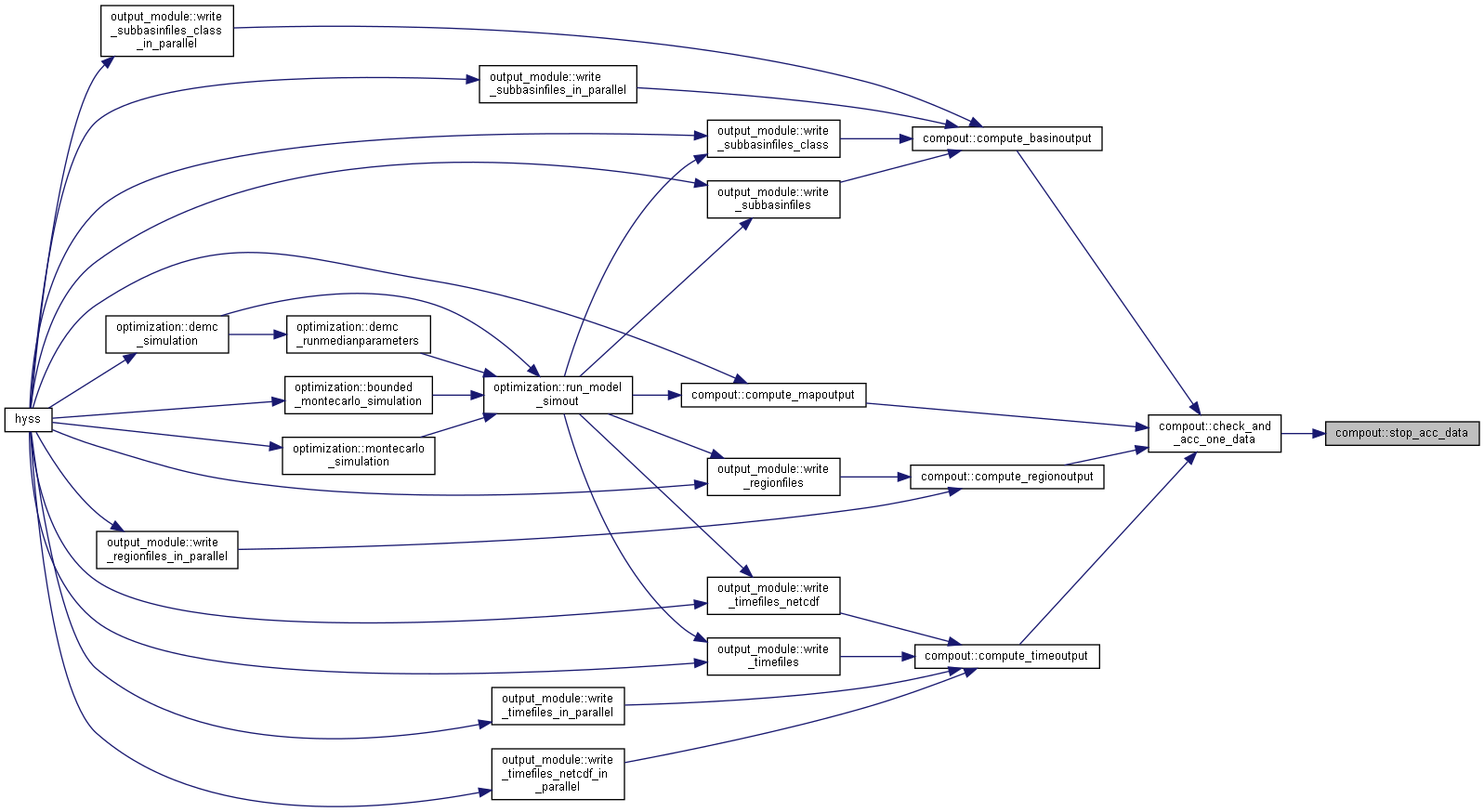Functions/Subroutines | |
| subroutine | compute_load_accumulation_period_status (date, loadvar, nper, pstart, pend) |
| subroutine | compute_period_timesteplength_and_end_status (ct, pcode, nper, pend, pfull, idt, ndt) |
| subroutine | acc_one_data (sumtype, y, yhelp, acc, acch) |
| subroutine | stop_acc_data (miss, acc, accok) |
| subroutine | check_and_acc_one_data (simple, sumtype, y, yhelp, miss, acc, acchelp, accok) |
| subroutine | check_and_outmean_one_data (sumtype, pcode, nper, miss, acc, acch, x) |
| subroutine, public | compute_basinoutput (io, iad, dim, pwrite, pend, nper, idt, iens, x) |
| subroutine, public | compute_mapoutput (ct, io, idt, ndt, intformat, nmapperiod) |
| subroutine, public | compute_print_output_flags (ct, io, idt, ndt, nper, pwrite, pend, wuskip) |
| subroutine, public | compute_timeoutput (io, ivar, dim, pwrite, pend, nper, idt, iens, x) |
| subroutine, public | compute_regionoutput (io, ir, iad, dim, pwrite, pend, nper, idt, iens, x) |
| subroutine, public | compute_outloads (d, pend, idt) |
| subroutine, public | initiate_outvar (idt) |
| subroutine, public | revise_outvar () |
| subroutine, public | calculate_class_average (varindex, ncl, classindex, avvalue) |
| subroutine, public | calculate_class_weighted_average (varindex, varindex0, ncl, classindex, avvalue) |
| subroutine, public | calculate_region_average (ireg, ivar, average) |
| subroutine, public | calculate_region_obsfunc (ireg) |
| subroutine, public | calculate_upstream_average (varindex, areatype, avvalue) |
| subroutine, public | prepare_to_compute_crit (ct, idt, ndt) |
| subroutine, public | calculate_criteria (crit0, basincrit, simcrit, crit1, thres1) |
| subroutine | add_max_criterion_to_objective (i, value, objcrit, condcrit, condthres) |
| subroutine | add_min_criterion_to_objective (i, value, objcrit, condcrit, condthres) |
| integer function, public | find_variable_index_type (str, outindex, timeagg, areaagg) |
| integer function, public | find_variable_index (str, iout, flow) |
| character(len=20) function, public | get_variable_string (outputvariable) |
| character(len=30) function, public | get_unit_string (io, ivar) |
| real function | compute_yearfact (vartype, per) |
| real function | compute_sr2limit (yearlim, per) |
| subroutine, public | find_acrit_corresponding_to_crit (i, iout) |
| subroutine | find_crit_corresponding_to_acrit (j, iout) |
| subroutine | save_variables_for_later_critcalc (n, icrit, cs, rs, ts) |
| subroutine | extend_ktvariables (n, m, i) |
| subroutine | accumulate_periodvalues (m, n, r, c, rs, cs, ts) |
| subroutine | reform_accumulated_periodvalues (n, acctype, rs, cs, ts) |
| subroutine | reset_periodvalues (rs, cs, ts, n, m) |
| subroutine | kendallstau (n, data1, data2, tau) |
| subroutine | calculate_fit (n, c, r, m, lim, x) |
| subroutine | calculate_mab (n, c, r, m, lim, usew, w, x) |
| subroutine | calculate_ra (n, c, r, m, p, lim, x) |
| subroutine, public | calculate_median (n, x, miss, median) |
| subroutine | calculate_mean_criterion (dim, usew, crit, w, ave) |
| subroutine | calculate_meanabs_criterion (dim, usew, crit, w, ave) |
| subroutine | calculate_subbasin_mean_var (iac, limityear, dim, vartype, rec, sim) |
| subroutine | calculate_nash_sutcliffe (iac, dim, r2) |
| subroutine | calculate_regional_nash_sutcliffe (iac, rr2) |
| subroutine | calculate_regional_number_of_observations (iac, num) |
| subroutine | calculate_meanmedian_number_of_observations (dim, crit, miss, num) |
| subroutine | calculate_spatial_nash_sutcliffe (iac, limityear, limitbasin, vartype, sr2) |
| subroutine | calculate_spatial_root_mean_square_error (iac, limityear, limitbasin, vartype, srmse) |
| subroutine | calculate_spatial_mean_absolute_bias (iac, limityear, limitbasin, vartype, smab) |
| subroutine | calculate_all_subbasins_tau (iac, dim, tau) |
| subroutine | calculate_all_subbasins_ra (iac, dim, acoeff, ra) |
| subroutine | calculate_regional_ra (iac, acoeff, rra) |
| subroutine | calculate_relative_error (iac, dim, re) |
| subroutine | calculate_regional_relative_error (iac, rve) |
| subroutine | calculate_mean_and_errors (iac, dim, rec, sim, rmae, rmse, nrmse, n) |
| subroutine | calculate_regional_errors (iac, rmae) |
| subroutine | calculate_variance_based_criteria (iac, dim, recstd, simstd, stderr, stdrelerr, corr, nsew) |
| subroutine | calculate_kling_gupta (iac, dim, kge, sckge, kge1, kge2, kge3) |
| subroutine | calculate_minmax_subass (iac, mmvalues) |
Detailed Description
The module compout contains procedures relating to calculating output and criteria.
Procedures for for accumulation output data and for preparing output for file writing. Output are accumulated to the time period wanted for print out and for criteria calculations. Several different criteria is calculated.
Function/Subroutine Documentation
◆ acc_one_data()
| subroutine compout::acc_one_data | ( | integer, intent(in) | sumtype, |
| real, intent(in) | y, | ||
| real, intent(in) | yhelp, | ||
| real, intent(inout) | acc, | ||
| real, intent(inout) | acch | ||
| ) |
Accumulate one data point Depending on type of output variable accumulate data.
- Parameters
-
[in] sumtype Type of output variable [in] y Data [in] yhelp Help data (water for weighting) [in,out] acc Variable for accumulated data [in,out] acch Variable for accumulated help data
 Here is the caller graph for this function:
Here is the caller graph for this function:◆ accumulate_periodvalues()
| subroutine compout::accumulate_periodvalues | ( | real, intent(in) | m, |
| integer, intent(in) | n, | ||
| real, dimension(n), intent(in) | r, | ||
| real, dimension(n), intent(in) | c, | ||
| real, dimension(n), intent(inout) | rs, | ||
| real, dimension(n), intent(inout) | cs, | ||
| integer, dimension(n), intent(inout) | ts | ||
| ) |
Accumulate values to mean period used by criterion.
- Parameters
-
[in] m Mask value, missing value [in] n Size of variables, number of subbasins [in] r Recorded value of variable to be used for criteria [in] c Computed value of variable to be used for criteria [in,out] rs Accumulation of recorded value [in,out] cs Accumulation of computed value [in,out] ts Accumulation of number of values
 Here is the caller graph for this function:
Here is the caller graph for this function:◆ add_max_criterion_to_objective()
| subroutine compout::add_max_criterion_to_objective | ( | integer, intent(in) | i, |
| real, intent(in) | value, | ||
| real, intent(inout) | objcrit, | ||
| real, intent(inout) | condcrit, | ||
| real, intent(inout) | condthres | ||
| ) |
Add criterion value to multi-criteria objective function or to conditional criterion for a criterion to be maximised, e.g. NSE.
 Here is the caller graph for this function:
Here is the caller graph for this function:◆ add_min_criterion_to_objective()
| subroutine compout::add_min_criterion_to_objective | ( | integer, intent(in) | i, |
| real, intent(in) | value, | ||
| real, intent(inout) | objcrit, | ||
| real, intent(inout) | condcrit, | ||
| real, intent(inout) | condthres | ||
| ) |
Add criterion value to multi-criteria objective function or to conditional criterion for a criterion to be minimised, e.g. RMSE.
 Here is the caller graph for this function:
Here is the caller graph for this function:◆ calculate_all_subbasins_ra()
| subroutine compout::calculate_all_subbasins_ra | ( | integer, intent(in) | iac, |
| integer, intent(in) | dim, | ||
| real, intent(in) | acoeff, | ||
| real, dimension(dim), intent(out) | ra | ||
| ) |
Calculate Nash-Sutcliffe effciency with parameter a instead of 2 for all time series, "RA".
- Parameters
-
[in] iac Index of accumulation criteria [in] dim Dimension of array, number of subbasins [in] acoeff Coefficient a for RA criterion [out] ra Calculated criteria, RA
Algorithm
For each subbasin: Calculate criteria RA
 Here is the call graph for this function:
Here is the call graph for this function: Here is the caller graph for this function:
Here is the caller graph for this function:◆ calculate_all_subbasins_tau()
| subroutine compout::calculate_all_subbasins_tau | ( | integer, intent(in) | iac, |
| integer, intent(in) | dim, | ||
| real, dimension(dim), intent(out) | tau | ||
| ) |
Calculate Kendalls tau for all subbasins.
- Parameters
-
[in] iac Index of accumulated criteria [in] dim Dimension of array, number of subbasins [out] tau Calculated criteria, Kendalls tau
Algorithm
For each subbasin: Calculate kendalls tau
 Here is the call graph for this function:
Here is the call graph for this function: Here is the caller graph for this function:
Here is the caller graph for this function:◆ calculate_class_average()
| subroutine, public compout::calculate_class_average | ( | integer, intent(in) | varindex, |
| integer, intent(in) | ncl, | ||
| integer, dimension(ncl), intent(in) | classindex, | ||
| real, dimension(nsub), intent(out) | avvalue | ||
| ) |
Calculate a simple average of selected class values of a variable for all subbasins.
- Parameters
-
[in] varindex index of variable's class values [in] ncl number of selected classes [in] classindex index of selected classes [out] avvalue class average values
Algoritm
Calculate average value of selected classes
 Here is the caller graph for this function:
Here is the caller graph for this function:◆ calculate_class_weighted_average()
| subroutine, public compout::calculate_class_weighted_average | ( | integer, intent(in) | varindex, |
| integer, intent(in) | varindex0, | ||
| integer, intent(in) | ncl, | ||
| integer, dimension(ncl), intent(in) | classindex, | ||
| real, dimension(nsub), intent(out) | avvalue | ||
| ) |
Calculate a water weighted average of selected class values of a variable for all subbasins.
- Parameters
-
[in] varindex index of variable's class values [in] varindex0 index of variable's corresponding water class values [in] ncl number of selected classes [in] classindex index of selected classes [out] avvalue class average values
Algoritm
Calculate weighted average value of selected classes
 Here is the caller graph for this function:
Here is the caller graph for this function:◆ calculate_criteria()
| subroutine, public compout::calculate_criteria | ( | real, intent(out) | crit0, |
| real, dimension(nsubcrit,maxsubass,nacrit), intent(out), optional | basincrit, | ||
| real, dimension(maxperf,nacrit), intent(out), optional | simcrit, | ||
| real, intent(out), optional | crit1, | ||
| real, intent(out), optional | thres1 | ||
| ) |
Calculates objective function (chosen multi-criteria) for the last time step. Calculates optional other criteria.
Consequences Worldvar module variables ktcomp,ktrec and ktnum etc. may be allocated and changed (sort of?).
- Parameters
-
[out] crit0 Value of chosen objective function [out] basincrit Performance criteria per subbasin and variable [out] simcrit Performance criteria per variable [out] crit1 Conditional criteria [out] thres1 Threshold of conditional criteria
Algorithm
Initializations
For every criteria with unique variables:
If assessment print out: Calculate diagnostic criteria (R2, RE etc) for each subbasin
If subbasin assessment: Set optional subbasin assessment criteria dummy argument
If simulation assessment: Calculate and set simulation assessment criteria. These could be average and median of subbasin criteria or regional or spatial criteria.
If simulation assessment: Calculate and set simulation assessment criteria, spatial and combined ("regional")
Calculate the multi-criteria optimization criterion, i.e. the objective function
For every criterion included in the objective function:
- If TAU: Calculate Kendalls tau for each subbasin, calculate mean TAU, add to objective function or conditional criteria
- If RRA: Calculate regional RA, add to objective function or conditional criteria
- If SRA: Calculate variable's average for each subbasin, calculate RA on these (spatial RA), add to objective function or conditional criteria
- If SR2: Calculate spatial NSE if not already done, add to objective function or conditional criteria
- If SNR: Calculate spatial RMSE if not already done, add to objective function or conditional criteria
- If SMB: Calculate spatial Mean Absolute Bias if not already done, add to objective function or conditional criteria
- If RR2: Calculate regional NSE if not already done, add to objective function or conditional criteria
- If MR2: Calculate NSE for every subbasin and their average if not already done, add to objective function or conditional criteria
- If MD2: Calculate NSE for every subbasin and their median if not already done, add to objective function or conditional criteria
- If MRA: Calculate RA for every subbasin, calculate their average, add to objective function or conditional criteria
- If MDA: Calculate RA for every subbasin, calculate their median, add to objective function or conditional criteria
- If RRE: Calculate regional relative error if not already done, add to objective function or conditional criteria
- If MRE: Calculate relative error of mean for every subbasin and their average if not already done, add to objective function or conditional criteria
- If MAR: Calculate relative for every subbasin and the average of their absolute value if not already done, add to objective function or conditional criteria
- If MCC: Calculate correlation coefficient for every subbasin and their average if not already done, add to objective function or conditional criteria
- If MKG: Calculate Kling-Gupta Efficiency for every subbasin and their median if not already done, add to objective function or conditional criteria
- If AKG: Calculate Kling-Gupta Efficiency for every subbasin and their mean if not already done, add to objective function or conditional criteria
- If ASK: Calculate rescaled Kling-Gupta Efficiency for every subbasin and their mean if not already done, add to objective function or conditional criteria
- If MRS: Calculate error in standard deviations for every subbasin and their average if not already done, add to objective function or conditional criteria
- If MNR: Calculate normalised RMSE by max for every subbasin and their median if not already done, add to objective function or conditional criteria
- If NSW: Calculate NSE adjusted for bias for every subbasin and their average if not already done, add to objective function or conditional criteria
Set output variables
Deallocate help variables for calculating Kendalls Tau or RA
 Here is the call graph for this function:
Here is the call graph for this function: Here is the caller graph for this function:
Here is the caller graph for this function:◆ calculate_fit()
|
private |
Calculate three fitness criteria between two arrays of length n.
- Parameters
-
[in] n Number of elements [in] c Array with computed values [in] r Array with recorded values [in] m Missing value [in] lim Minimum number of elements [out] x Fitness criteria; 1=R2 (Nash-Sutcliff), 2=RMSE, 3=bias, and 4=number of data used
Algorithm
Initialize
Calculate sum of values and errors (for not missing values)
If enough values not missing; calculate fitness criteria
 Here is the caller graph for this function:
Here is the caller graph for this function:◆ calculate_kling_gupta()
| subroutine compout::calculate_kling_gupta | ( | integer, intent(in) | iac, |
| integer, intent(in) | dim, | ||
| real, dimension(dim), intent(out) | kge, | ||
| real, dimension(dim), intent(out) | sckge, | ||
| real, dimension(dim), intent(out) | kge1, | ||
| real, dimension(dim), intent(out) | kge2, | ||
| real, dimension(dim), intent(out) | kge3 | ||
| ) |
Calculate Kling-Gupta effciency for all time series, "KGE".
Reference Gupta et al. 2009 KGE = 1 - sqrt{ (cc-1)^2 + (a-1)^2 + (b-1)^2 } cc = linear correlation coefficient a = std(SIM)/std(OBS) b = mean(SIM)/mean(OBS)
- Parameters
-
[in] iac Index of accumulation criteria [in] dim Dimension of array, number of subbasins [out] kge Kling-Gupta efficiency [out] sckge Kling-Gupta efficiency rescaled to (-1,1) [out] kge1 Kling-Gupta efficiency part 1, cc [out] kge2 Kling-Gupta efficiency part 2, std-quotient [out] kge3 Kling-Gupta efficiency part 3, mean-quotient
Algorithm
For every subbasin with enough data: calculate criteria
 Here is the caller graph for this function:
Here is the caller graph for this function:◆ calculate_mab()
|
private |
Calculates fitness criterion, mean absolute scaled bias.
- Parameters
-
[in] n Number of elements [in] c Array with computed values [in] r Array with recorded values [in] m Missing value [in] lim Minimum number of elements [in] usew Status of using weights on subbasin [in] w Weight for averaging criteria [out] x Fitness criteria; weighted average of absolute scaled bias
Algorithm
Initialize
Calculate sum of values (for not missing values)
If enough values not missing; calculate fitness criteria
 Here is the caller graph for this function:
Here is the caller graph for this function:◆ calculate_mean_and_errors()
| subroutine compout::calculate_mean_and_errors | ( | integer, intent(in) | iac, |
| integer, intent(in) | dim, | ||
| real, dimension(dim), intent(out) | rec, | ||
| real, dimension(dim), intent(out) | sim, | ||
| real, dimension(dim), intent(out) | rmae, | ||
| real, dimension(dim), intent(out) | rmse, | ||
| real, dimension(dim), intent(out) | nrmse, | ||
| integer, dimension(dim), intent(out) | n | ||
| ) |
Calculate mean absolute error and root mean square error for all time series, "MAE and RMSE". Calculate mean values for observations and simulation.
- Parameters
-
[in] iac index of accumulation criteria [in] dim dimension of criteria [out] rec mean recorded value [out] sim mean simulated value [out] rmae mean absolute error [out] rmse root mean square error [out] nrmse normalized root mean square error, rmse/maxRec (rmse/(maxRec-MinRec)?) [out] n number of observations used
 Here is the caller graph for this function:
Here is the caller graph for this function:◆ calculate_mean_criterion()
|
private |
Calculate (subbasin) mean value of criterion; arithmetic mean or weighted mean.
- Parameters
-
[in] dim Dimension of array, subbasins [in] usew Status of using weighted mean [in] crit Array with criteria [in] w Weight for averaging criteria [out] ave Average of criteria
 Here is the caller graph for this function:
Here is the caller graph for this function:◆ calculate_meanabs_criterion()
| subroutine compout::calculate_meanabs_criterion | ( | integer, intent(in) | dim, |
| logical, intent(in) | usew, | ||
| real, dimension(dim), intent(in) | crit, | ||
| real, dimension(:), intent(in), allocatable | w, | ||
| real, intent(out) | ave | ||
| ) |
Calculate subbasin mean absolute value of criterion.
- Parameters
-
[in] dim Dimension of array, subbasins [in] usew Status of using weighted mean [in] crit Array with criteria [out] ave Average of criteria [in] w Weight for averaging criteria
 Here is the caller graph for this function:
Here is the caller graph for this function:◆ calculate_meanmedian_number_of_observations()
| subroutine compout::calculate_meanmedian_number_of_observations | ( | integer, intent(in) | dim, |
| real, dimension(dim), intent(in) | crit, | ||
| real, intent(in) | miss, | ||
| real, intent(out) | num | ||
| ) |
Calculate number of data point used for calculation of "regional" criteria.
- Parameters
-
[in] dim number of areas [in] crit criteria value for areas [in] miss missing value [out] num Number of areas with criteria
 Here is the caller graph for this function:
Here is the caller graph for this function:◆ calculate_median()
| subroutine, public compout::calculate_median | ( | integer, intent(in) | n, |
| real, dimension(n), intent(in) | x, | ||
| real, intent(in) | miss, | ||
| real, intent(out) | median | ||
| ) |
Calculate median of non-missing values in array.
- Parameters
-
[in] n Number of elements [in] x Array with values [in] miss Missing value [out] median Median value
Algorithm
Calculate the median simle for small arrays, the return
Calculate the place of the median element
Calculate the median
 Here is the caller graph for this function:
Here is the caller graph for this function:◆ calculate_minmax_subass()
| subroutine compout::calculate_minmax_subass | ( | integer, intent(in) | iac, |
| real, dimension(:,:), intent(out) | mmvalues | ||
| ) |
Calculate min and max value of simulated and observed time series.
- Parameters
-
[in] iac Index of accumulation criteria [out] mmvalues Min and max values (dim,4)
Algorithm
For every subbasin with enough data: calculate criteria
 Here is the caller graph for this function:
Here is the caller graph for this function:◆ calculate_nash_sutcliffe()
| subroutine compout::calculate_nash_sutcliffe | ( | integer, intent(in) | iac, |
| integer, intent(in) | dim, | ||
| real, dimension(dim), intent(out) | r2 | ||
| ) |
Calculate Nash-Sutcliffe effciency ("R2") for all subbasins.
- Parameters
-
[in] iac Index of accumulation criteria [in] dim Dimension of array, number of subbasins [out] r2 Nash-Sutcliffe efficiency
 Here is the caller graph for this function:
Here is the caller graph for this function:◆ calculate_ra()
|
private |
Calculates fitness criterion, "RA", for two columns of an array of length n. Criterion RA is similar to NSE but with exponent p instead of 2.
- Parameters
-
[in] n Number of elements [in] c Array with computed values [in] r Array with recorded values [in] m Missing value [in] p Parameter value of criterion [in] lim Minimum number of elements [out] x Fitness criterion 1=RA
Algorithm
Initialize
Calculate sum of values and errors (for not missing values)
If enough values not missing; calculate fitness criteria
 Here is the caller graph for this function:
Here is the caller graph for this function:◆ calculate_region_average()
| subroutine, public compout::calculate_region_average | ( | integer, intent(in) | ireg, |
| integer, intent(in) | ivar, | ||
| real, intent(out) | average | ||
| ) |
Calculate the region average of a subbasin variable for one region, unless another function than the average is asked for in which case missing value is returned.
- Parameters
-
[in] ireg current region [in] ivar index of output variable (in outvar) [out] average region average value
Algoritm
Calculate region average of the variable for the region, by adding the subbasin values multiplied by their weight in the average.
 Here is the caller graph for this function:
Here is the caller graph for this function:◆ calculate_region_obsfunc()
| subroutine, public compout::calculate_region_obsfunc | ( | integer, intent(in) | ireg | ) |
Calculate the region observation functions for an outregion.
- Parameters
-
[in] ireg current region
Algoritm
Select observation function
Obsfunc 1: Calculate reservoir inflow as local runoff + precipitation on reservoir minus evaporation of reservoir
- 1. Find outvar columns with regionalized clrf, clrp, clre, and qcin
- 2. Apply the regional observation function if rgqcin is to be output
Obsfunc 2: Not implemented yet.
- find out which snow variables are regionalized (which will be interpolated to the in-situ point)
 Here is the caller graph for this function:
Here is the caller graph for this function:◆ calculate_regional_errors()
| subroutine compout::calculate_regional_errors | ( | integer, intent(in) | iac, |
| real, intent(out) | rmae | ||
| ) |
Calculate mean absolute error and mean square error for all time series as one time series, "regional MAE and MSE".
- Parameters
-
[in] iac Index of accumulation criteria [out] rmae Regional mean absolute error
Algorithm
Accumulate data over all subbasins
Calculate regional MAE of all observations
 Here is the caller graph for this function:
Here is the caller graph for this function:◆ calculate_regional_nash_sutcliffe()
| subroutine compout::calculate_regional_nash_sutcliffe | ( | integer, intent(in) | iac, |
| real, intent(out) | rr2 | ||
| ) |
Calculate Nash-Sutcliffe effciency for all time series as one time series, "regional R2".
- Parameters
-
[in] iac Index of accumulation criteria [out] rr2 Calculated criterion, regional R2
 Here is the caller graph for this function:
Here is the caller graph for this function:◆ calculate_regional_number_of_observations()
| subroutine compout::calculate_regional_number_of_observations | ( | integer, intent(in) | iac, |
| real, intent(out) | num | ||
| ) |
Calculate number of data point used for calculation of "regional" criteria.
- Parameters
-
[in] iac Index of accumulation criteria [out] num Number of data points
 Here is the caller graph for this function:
Here is the caller graph for this function:◆ calculate_regional_ra()
| subroutine compout::calculate_regional_ra | ( | integer, intent(in) | iac, |
| real, intent(in) | acoeff, | ||
| real, intent(out) | rra | ||
| ) |
Calculate Nash-Sutcliffe effciency with coeffcient a for all time series as one time series, "regional RA".
- Parameters
-
[in] iac Index of accumulation criteria [in] acoeff Coefficient a for RA criterion [out] rra Calculated criteria, regional RA
Algorithm
Prepare arrays to hold all data in the time series
Set the arrays with all data in the time series
Calculate RA for these large data arrays
 Here is the call graph for this function:
Here is the call graph for this function: Here is the caller graph for this function:
Here is the caller graph for this function:◆ calculate_regional_relative_error()
| subroutine compout::calculate_regional_relative_error | ( | integer, intent(in) | iac, |
| real, intent(out) | rve | ||
| ) |
Calculate relative volume error for all time series as one time series, "regional RE".
- Parameters
-
[in] iac Index of accumulation criteria [out] rve Regional relative error
Algorithm
Accumulate data over all subbasins
Calculate regional relative volume error
 Here is the caller graph for this function:
Here is the caller graph for this function:◆ calculate_relative_error()
| subroutine compout::calculate_relative_error | ( | integer, intent(in) | iac, |
| integer, intent(in) | dim, | ||
| real, dimension(dim), intent(out) | re | ||
| ) |
Calculate error relative to observed (absolute) mean value for all subbasins, "RE".
- Parameters
-
[in] iac Index of accumulation criteria [in] dim Dimension of array, number of subbasins [out] re Relative error
 Here is the caller graph for this function:
Here is the caller graph for this function:◆ calculate_spatial_mean_absolute_bias()
| subroutine compout::calculate_spatial_mean_absolute_bias | ( | integer, intent(in) | iac, |
| integer, intent(in) | limityear, | ||
| integer, intent(in) | limitbasin, | ||
| integer, intent(in) | vartype, | ||
| real, intent(out) | smab | ||
| ) |
Calculate Mean absolute scaled bias with subbasins as time series, "SMB".
- Parameters
-
[in] iac Index of accumulation criteria [in] limityear Minimum years with data (5) [in] limitbasin Minimum basins with data (5) [in] vartype Variable type (state,flow or concentration) [out] smab Criteria, spatial mean absolute bias
Algorithm
Calculate average of variables for each subbasin
Transformation, natural logarithm
Calculate fit from the subbasin averages
Set output
 Here is the call graph for this function:
Here is the call graph for this function: Here is the caller graph for this function:
Here is the caller graph for this function:◆ calculate_spatial_nash_sutcliffe()
|
private |
Calculate Nash-Sutcliffe efficiency with subbasins as time series, "spatial R2".
- Parameters
-
[in] iac Index of accumulation criteria [in] limityear Minimum years with data (5) [in] limitbasin Minimum basins with data (5) [in] vartype Variable type (state,flow or concentration) [out] sr2 Criteria, spatial R2
Algorithm
Calculate average of variables for each subbasin
Calculate Nash-Sutcliffe efficiency from the subbasin averages
 Here is the call graph for this function:
Here is the call graph for this function: Here is the caller graph for this function:
Here is the caller graph for this function:◆ calculate_spatial_root_mean_square_error()
| subroutine compout::calculate_spatial_root_mean_square_error | ( | integer, intent(in) | iac, |
| integer, intent(in) | limityear, | ||
| integer, intent(in) | limitbasin, | ||
| integer, intent(in) | vartype, | ||
| real, intent(out) | srmse | ||
| ) |
Calculate RMSE with subbasins as time series, "spatial RMSE".
- Parameters
-
[in] iac Index of accumulation criteria [in] limityear Minimum years with data (5) [in] limitbasin Minimum basins with data (5) [in] vartype Variable type (state,flow or concentration) [out] srmse Criteria, spatial RMSE
Algorithm
Calculate average of variables for each subbasin
Calculate RMSE from the subbasin averages
Scale with average of observations
 Here is the call graph for this function:
Here is the call graph for this function: Here is the caller graph for this function:
Here is the caller graph for this function:◆ calculate_subbasin_mean_var()
| subroutine compout::calculate_subbasin_mean_var | ( | integer, intent(in) | iac, |
| integer, intent(in) | limityear, | ||
| integer, intent(in) | dim, | ||
| integer, intent(in) | vartype, | ||
| real, dimension(dim), intent(out) | rec, | ||
| real, dimension(dim), intent(out) | sim | ||
| ) |
Calculate average value for each subbasin of simulated and recorded variable.
- Parameters
-
[in] iac Index of accumularion criteria [in] limityear Minimum years with data (5) [in] dim Dimension of data arrays, subbasins [in] vartype Variable type (state,flow or concentration) [out] rec Recorded variable subbasin yearmean or yearsum [out] sim Computed variable subbasin yearmeanor yearsum
 Here is the call graph for this function:
Here is the call graph for this function: Here is the caller graph for this function:
Here is the caller graph for this function:◆ calculate_upstream_average()
| subroutine, public compout::calculate_upstream_average | ( | integer, intent(in) | varindex, |
| integer, intent(in) | areatype, | ||
| real, dimension(nsub), intent(out) | avvalue | ||
| ) |
Calculate the upstream average of a variable for all subbasins.
- Parameters
-
[in] varindex outvar index of variable to be averaged [in] areatype basinarea or landarea variable [out] avvalue upstream average
Algoritm
Return if the upstream variable not have an associated base area
Accumulate values downstream
 Here is the caller graph for this function:
Here is the caller graph for this function:◆ calculate_variance_based_criteria()
| subroutine compout::calculate_variance_based_criteria | ( | integer, intent(in) | iac, |
| integer, intent(in) | dim, | ||
| real, dimension(dim), intent(out) | recstd, | ||
| real, dimension(dim), intent(out) | simstd, | ||
| real, dimension(dim), intent(out) | stderr, | ||
| real, dimension(dim), intent(out) | stdrelerr, | ||
| real, dimension(dim), intent(out) | corr, | ||
| real, dimension(dim), intent(out) | nsew | ||
| ) |
Calculate standard deviation of observations and simulated values for all time series. Also calculate error, relative error and correlation of the standard deviation.
- Parameters
-
[in] iac index of accumulation criteria [in] dim dimension of criteria, number of subbasins [out] recstd recorded standard deviation [out] simstd simulated standard deviation [out] stderr error of standard deviation [out] stdrelerr relative error of standard deviation [out] corr correlation coefficient [out] nsew Nash-Sutcliffe efficiency adjusted for bias (NSE+bias^2/Var)
Algorithm
For every subbasin with enough data: calculate criteria
Calculate standard deviation, error and correlation
 Here is the caller graph for this function:
Here is the caller graph for this function:◆ check_and_acc_one_data()
|
private |
Check if data ok and then accumulate data.
- Parameters
-
[in] simple Flag for timesteply output [in] sumtype Accumulation type of data [in] y Data [in] yhelp Help data (water for weighting) [in] miss Missing value [in,out] acc Variable for accumulated data [in,out] acchelp Variable for accumulated help data [in,out] accok Variable for status of accumulation (0/1)
Algorithm
If timsteply output use the data as is (weight equal to 1)
Else: Depending on data accumulation type: accumulate or end accumulation
 Here is the call graph for this function:
Here is the call graph for this function: Here is the caller graph for this function:
Here is the caller graph for this function:◆ check_and_outmean_one_data()
| subroutine compout::check_and_outmean_one_data | ( | integer, intent(in) | sumtype, |
| integer, intent(in) | pcode, | ||
| integer, intent(in) | nper, | ||
| real, intent(in) | miss, | ||
| real, intent(in) | acc, | ||
| real, intent(in) | acch, | ||
| real, intent(out) | x | ||
| ) |
Compute the correct output average at the end of mean period for accumulated data based on average type, period length and missing data.
- Parameters
-
[in] sumtype Code for variable average type [in] pcode Code for period [in] nper Period length [in] miss Missing value [in] acc Variable for accumulated data [in] acch Variable for accumulated help data [out] x Average or sum of accumulated data
Algorithm
Calculate denominator for average depending on accumulation type
Calculate average
 Here is the caller graph for this function:
Here is the caller graph for this function:◆ compute_basinoutput()
| subroutine, public compout::compute_basinoutput | ( | integer, intent(in) | io, |
| integer, intent(in) | iad, | ||
| integer, intent(in) | dim, | ||
| logical, intent(in) | pwrite, | ||
| logical, intent(in) | pend, | ||
| integer, intent(in) | nper, | ||
| integer, intent(in) | idt, | ||
| integer, intent(in) | iens, | ||
| real, dimension(dim), intent(out) | x | ||
| ) |
Accumulate and calculate the mean of period for timeserie output for specific subbasin.
Consequences Module worldvar variables output change.
- Parameters
-
[in] io Current output [in] iad Current (index of selected) subbasin [in] dim Data dimension, number of variables for print out [in] pwrite Flag for end of period to be written [in] pend Flag for end of summation period [in] nper Number of timesteps in current period [in] idt Current time step number [in] iens Current simulation [out] x Data to file
Algorithm
Default output
Skip warmup period
For every variable for print out:
- Add value to period accumulation
- If end of period: calculate output average
 Here is the call graph for this function:
Here is the call graph for this function: Here is the caller graph for this function:
Here is the caller graph for this function:◆ compute_load_accumulation_period_status()
|
private |
Compute number of timesteps in period, and check if period is ending.
- Parameters
-
[in] date Current date [in] loadvar Accload structure [out] nper Number of timesteps in current period (calculated only if pend is true) [out] pstart Flag for started period [out] pend Flag for end of period
Algorithm
Set flag for current date in period
Check if end of period
 Here is the call graph for this function:
Here is the call graph for this function: Here is the caller graph for this function:
Here is the caller graph for this function:◆ compute_mapoutput()
| subroutine, public compout::compute_mapoutput | ( | type(timeinformationtype), intent(in) | ct, |
| integer, intent(in) | io, | ||
| integer, intent(in) | idt, | ||
| integer, intent(in) | ndt, | ||
| logical, intent(in) | intformat, | ||
| integer, intent(out) | nmapperiod | ||
| ) |
Accumulate and calculate the mean of period for map output.
Consequences Module variables output,maptime,tmap may change.
- Parameters
-
[in] ct Current time [in] io Current output [in] idt Current time step number [in] ndt Number of time steps in run [in] intformat Write matlab format [out] nmapperiod Number of periods for map print out
Algorithm
Skip warmup period
For every variable and subbasin for print out:
- Accumulate timestep data
- If end of period: calculate output average
If end of period: Set the map time and prepare for next accumulation period
Calculate number of periods for map print out (so far)
 Here is the call graph for this function:
Here is the call graph for this function: Here is the caller graph for this function:
Here is the caller graph for this function:◆ compute_outloads()
| subroutine, public compout::compute_outloads | ( | type(datetype), intent(in) | d, |
| logical, intent(out) | pend, | ||
| integer, intent(in) | idt | ||
| ) |
Accumulate yearly totals of nutrient loads from daily values. Can also accumulate for a shorter period if asked for.
Consequences Module variables accload may change.
- Parameters
-
[in] d Current date [out] pend Flag for writing load files, end of summation period [in] idt Current time step number
Algorithm
Skip warmup period
Check for period start and end
Check for negative accumulated loads (between lakebasins), zero them if found.
 Here is the call graph for this function:
Here is the call graph for this function: Here is the caller graph for this function:
Here is the caller graph for this function:◆ compute_period_timesteplength_and_end_status()
| subroutine compout::compute_period_timesteplength_and_end_status | ( | type(timeinformationtype), intent(in) | ct, |
| integer, intent(in) | pcode, | ||
| integer, intent(out) | nper, | ||
| logical, intent(out) | pend, | ||
| logical, intent(out) | pfull, | ||
| integer, intent(in) | idt, | ||
| integer, intent(in) | ndt | ||
| ) |
Compute number of timesteps in accumulation period, and check if period is ending.
- Parameters
-
[in] ct Current time [in] pcode Code for period [out] nper Number of timesteps in current period (calculated only if pend is true) [out] pend Flag for end of summation period [out] pfull Flag for full summation period at end [in] idt Current time step [in] ndt Number of time steps in run
Algorithm
Calculate day of year, day of month, last day of year etc. Calculate end of year, month, week and day.
Depending on current period: Calculate number of time steps in period and check if end of period
 Here is the call graph for this function:
Here is the call graph for this function: Here is the caller graph for this function:
Here is the caller graph for this function:◆ compute_print_output_flags()
| subroutine, public compout::compute_print_output_flags | ( | type(timeinformationtype), intent(in) | ct, |
| integer, intent(in) | io, | ||
| integer, intent(in) | idt, | ||
| integer, intent(in) | ndt, | ||
| integer, intent(out) | nper, | ||
| logical, intent(out) | pwrite, | ||
| logical, intent(out) | pend, | ||
| logical, intent(out) | wuskip | ||
| ) |
Check if time for output of meanperiod timeserie output, and if output is timesteply.
Consequences Worldvar module variables output may change.
- Parameters
-
[in] ct Current time [in] io Current output [in] idt Current time step number [in] ndt Number of time steps in run [out] nper Number of timesteps in current period [out] pwrite Flag for end of period to be written [out] pend Flag for end of summation period [out] wuskip Flag for skipping warmup period
Algorithm
Default values
Skip warmup period
 Here is the call graph for this function:
Here is the call graph for this function: Here is the caller graph for this function:
Here is the caller graph for this function:◆ compute_regionoutput()
| subroutine, public compout::compute_regionoutput | ( | integer, intent(in) | io, |
| integer, intent(in) | ir, | ||
| integer, intent(in) | iad, | ||
| integer, intent(in) | dim, | ||
| logical, intent(in) | pwrite, | ||
| logical, intent(in) | pend, | ||
| integer, intent(in) | nper, | ||
| integer, intent(in) | idt, | ||
| integer, intent(in) | iens, | ||
| real, dimension(dim), intent(out) | x | ||
| ) |
Accumulate and calculate the mean of output period for region output for one region.
Consequences Module worldvar variable output may change.
- Parameters
-
[in] io Current output [in] ir Current region (region order) [in] iad Index of accdata (of current region) [in] dim Data dimension, number of variables for print out [in] pwrite Flag for end of period to be written [in] pend Flag for end of summation period [in] nper Number of timesteps in current period [in] idt Current time step number [in] iens Current simulation [out] x Data, calculated period mean
Algorithm
Default output
Skip warmup period
For every variable for print out:
- Add value to period accumulation
- If end of period: calculate output average
 Here is the call graph for this function:
Here is the call graph for this function: Here is the caller graph for this function:
Here is the caller graph for this function:◆ compute_sr2limit()
| real function compout::compute_sr2limit | ( | integer, intent(in) | yearlim, |
| integer, intent(in) | per | ||
| ) |
Calculate minimum number of data points necessary to have minimum number of years with data for SR2-criterium calculation.
- Parameters
-
[in] yearlim Mimimum number of years needed [in] per Accumulation period code
- Return values
-
compute:sr2limit number of data points needed
 Here is the call graph for this function:
Here is the call graph for this function: Here is the caller graph for this function:
Here is the caller graph for this function:◆ compute_timeoutput()
| subroutine, public compout::compute_timeoutput | ( | integer, intent(in) | io, |
| integer, intent(in) | ivar, | ||
| integer, intent(in) | dim, | ||
| logical, intent(in) | pwrite, | ||
| logical, intent(in) | pend, | ||
| integer, intent(in) | nper, | ||
| integer, intent(in) | idt, | ||
| integer, intent(in) | iens, | ||
| real, dimension(dim), intent(out) | x | ||
| ) |
Accumulate and calculate the mean of period for timeserie output for one variable.
Consequences Worldvar module variables output may change.
- Parameters
-
[in] io Current output [in] ivar Current output variable [in] dim Number of subbasins/outregions [in] pwrite Flag for end of period to be written [in] pend Flag for end of summation period [in] nper Number of timesteps in current period [in] idt Current time step number [in] iens Current simulation [out] x Data to file
Algorithm
Default output
Skip warmup period
For every subbasin:
- Accumulate timestep data
- If end of period: calculate output average and reset accumulation variables
 Here is the call graph for this function:
Here is the call graph for this function: Here is the caller graph for this function:
Here is the caller graph for this function:◆ compute_yearfact()
| real function compout::compute_yearfact | ( | integer, intent(in) | vartype, |
| integer, intent(in) | per | ||
| ) |
Calculate the scaling factor to get the yearly mean value based on a value of the current accumulation period.
- Parameters
-
[in] vartype type of accumulation for variable [in] per accumulation period code
- Return values
-
compute_yearfact scaling factor
Algorithm
If accumulation type is sum over period: Calculate scaling factor as number of time steps in period
If accumulation type is average over period: Calculate scaling factor as reciprocal of number of time steps in period
 Here is the call graph for this function:
Here is the call graph for this function: Here is the caller graph for this function:
Here is the caller graph for this function:◆ extend_ktvariables()
| subroutine compout::extend_ktvariables | ( | integer, intent(in) | n, |
| integer, intent(in) | m, | ||
| integer, intent(in) | i | ||
| ) |
Subroutine that extends two allocatable arrays by 100.
Consequences Module worldvar variables are increased in size
- Parameters
-
[in] n Number of values (subbasins) [in] m Second dimension, to be increased [in] i Current accumulated variable index
 Here is the caller graph for this function:
Here is the caller graph for this function:◆ find_acrit_corresponding_to_crit()
| subroutine, public compout::find_acrit_corresponding_to_crit | ( | integer, intent(in) | i, |
| integer, intent(out) | iout | ||
| ) |
Find what accumulated variables corresponds to current criteria variable.
- Parameters
-
[in] i Current criterion index [out] iout Accumulated variable index
 Here is the caller graph for this function:
Here is the caller graph for this function:◆ find_crit_corresponding_to_acrit()
| subroutine compout::find_crit_corresponding_to_acrit | ( | integer, intent(in) | j, |
| integer, intent(out) | iout | ||
| ) |
Find what criteria variable corresponds to current accumulated variable.
- Parameters
-
[in] j Accumulated variable index [out] iout Current criterion index
 Here is the caller graph for this function:
Here is the caller graph for this function:◆ find_variable_index()
| integer function, public compout::find_variable_index | ( | character(len=4), intent(in) | str, |
| integer, intent(out) | iout, | ||
| integer, intent(out) | flow | ||
| ) |
Finds the index for an output variable short name string.
- Parameters
-
[in] str variable short name [out] iout index of variable [out] flow type of variable (0=state,1=flow,2=conc)
- Return values
-
find_variable_index error status of function
Algorithm
Transform all variable name to lower case.
Find index of current output variable
If found: Set output dummy argument, else: return missing.
 Here is the call graph for this function:
Here is the call graph for this function: Here is the caller graph for this function:
Here is the caller graph for this function:◆ find_variable_index_type()
| integer function, public compout::find_variable_index_type | ( | character(len=*), intent(in) | str, |
| integer, intent(out) | outindex, | ||
| integer, intent(out) | timeagg, | ||
| integer, intent(out) | areaagg | ||
| ) |
Finds idindex and type for an output variable short name string.
- Parameters
-
[in] str variable short name [out] outindex index of variable [out] timeagg type of time period aggreagation (0=state,1=flow,2=conc) [out] areaagg type of area aggreagation (0=basin,1=upstream,2=region)
- Return values
-
find_variable_index_type error status of function
Algorithm
Transform all variable name to lower case.
Depending on area aggregation find variable index
 Here is the call graph for this function:
Here is the call graph for this function: Here is the caller graph for this function:
Here is the caller graph for this function:◆ get_unit_string()
| character(len=30) function, public compout::get_unit_string | ( | integer, intent(in) | io, |
| integer, intent(in) | ivar | ||
| ) |
Get the proper unit for output variables summed over a period.
- Parameters
-
[in] io current output [in] ivar current output variable
- Returns
- Return values
-
the unit spelled out for current period
- Returns
- Get unit of current variable
If summed variable; add the current period
 Here is the caller graph for this function:
Here is the caller graph for this function:◆ get_variable_string()
| character(len=20) function, public compout::get_variable_string | ( | type(outputvariabletype) | outputvariable | ) |
Get the name of a variable from output.
- Parameters
-
outputvariable variable from output; output(io)variable(ivar)
- Returns
- Return values
-
the variable name
 Here is the caller graph for this function:
Here is the caller graph for this function:◆ initiate_outvar()
| subroutine, public compout::initiate_outvar | ( | integer, intent(in) | idt | ) |
Initiate output variables to missing value.
Consequences Module modvar variables firstoutstep and outvar is set.
- Parameters
-
[in] idt current timestep
 Here is the caller graph for this function:
Here is the caller graph for this function:◆ kendallstau()
|
private |
Calculates Kendalls Tau, rank correlation, between two data sets with adjustment for ties.
- Parameters
-
[in] n Dimension of data set [in] data1 Data set 1 [in] data2 Data set 2 [in,out] tau Calculated Kendalls tau
 Here is the caller graph for this function:
Here is the caller graph for this function:◆ prepare_to_compute_crit()
| subroutine, public compout::prepare_to_compute_crit | ( | type(timeinformationtype), intent(in) | ct, |
| integer, intent(in) | idt, | ||
| integer, intent(in) | ndt | ||
| ) |
Accumulate data for criteria calculation.
Consequences Module worldvar variables critvec, rs,cs and ts may be allocated and/or changed
- Parameters
-
[in] ct Current time [in] idt Current time step number [in] ndt Number of time steps in run
Algorithm
Skip warmup period
Allocate criteria accumulation variables if not already done
If first time step of accumulation period: initialise accumulation variables
For every criteria with unique variables:
Accumulate data for period
If end of period:
- Upscale data for periods with not all observations
- If needed: save data for later (for Kendalls Tau and RA the variables need to be saved)
- For every subbasin/outregion: accumulate data period data for later criteria calculations
- (Re-)initialize accumulation variables
 Here is the call graph for this function:
Here is the call graph for this function: Here is the caller graph for this function:
Here is the caller graph for this function:◆ reform_accumulated_periodvalues()
|
private |
Reform period accumulate variables to average value for some variables.
- Parameters
-
[in] n Dimension of variables, number of subbasins [in] acctype Type of accumulation for variable; sum, mean, weighted mean*2 [in,out] rs Accumulation of recorded value [in,out] cs Accumulation of computed value [in,out] ts Accumulation of number of values
 Here is the caller graph for this function:
Here is the caller graph for this function:◆ reset_periodvalues()
| subroutine compout::reset_periodvalues | ( | real, dimension(n,m), intent(inout) | rs, |
| real, dimension(n,m), intent(inout) | cs, | ||
| integer, dimension(n,m), intent(inout) | ts, | ||
| integer, intent(in) | n, | ||
| integer, intent(in) | m | ||
| ) |
Reset the period accumulation variables.
- Parameters
-
[in] n Dimension of variables [in] m Dimension of variables [in,out] rs Accumulation of recorded value [in,out] cs Accumulation of computed value [in,out] ts Accumulation of number of values
 Here is the caller graph for this function:
Here is the caller graph for this function:◆ revise_outvar()
| subroutine, public compout::revise_outvar |
Set concentrations of waters with zero volume to missing_value and calculate regional and upstream average for output.
Consequences Module modvar variable outvar may be set.
Calculate outvar as class average for non-aggregated class outvars
Calculate new outvar for regional variables
Calculate new outvar for upstream variables
Set computed concentrations of waters with zero volume to missing_value
 Here is the call graph for this function:
Here is the call graph for this function: Here is the caller graph for this function:
Here is the caller graph for this function:◆ save_variables_for_later_critcalc()
| subroutine compout::save_variables_for_later_critcalc | ( | integer, intent(in) | n, |
| integer, intent(in) | icrit, | ||
| real, dimension(n), intent(in) | cs, | ||
| real, dimension(n), intent(in) | rs, | ||
| integer, dimension(n), intent(in) | ts | ||
| ) |
Save the variables needed to calculate Kendalls tau or RA after the simulation.
Consequences Worldvar module variables ktcomp,ktrec and ktnum etc may be allocated and set.
- Parameters
-
[in] n Number of values (subbasins) [in] icrit Current accumulated variable index [in] cs Computed value [in] rs Recorded value [in] ts Number of values used for cs,rs
Algorithm
Depending on index of accumulated variable:
- Allocate variables for holding values until end of simulation if necessary
- For every subbasin: If values exist set variable. If variable full increase its size.
 Here is the call graph for this function:
Here is the call graph for this function: Here is the caller graph for this function:
Here is the caller graph for this function:◆ stop_acc_data()
| subroutine compout::stop_acc_data | ( | real, intent(in) | miss, |
| real, intent(out) | acc, | ||
| integer, intent(out) | accok | ||
| ) |
Missing data, stop further accumulation for this period.
- Parameters
-
[in] miss Missing value [out] acc Variable for accumulation of data [out] accok Variable for status of accumulation (0/1)
 Here is the caller graph for this function:
Here is the caller graph for this function: